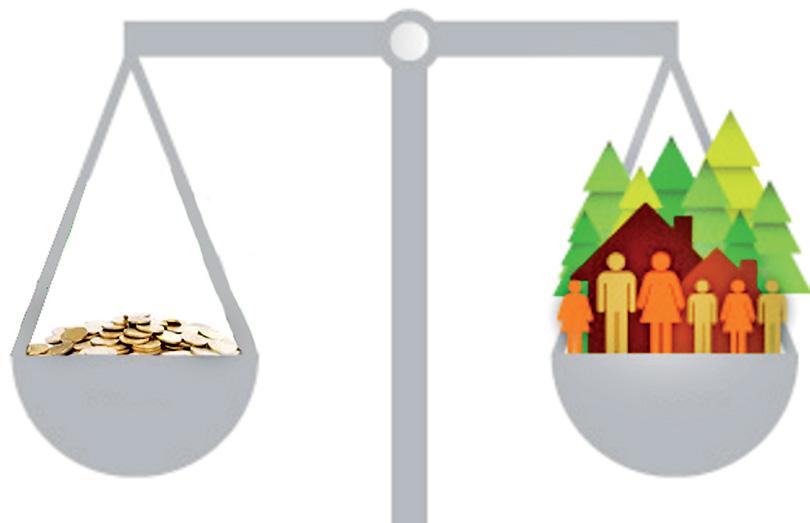10 Dec 2019 - {{hitsCtrl.values.hits}}

 Hardly a day has passed during the past few years without the media referring to microfinance negatively. The issue has now reached such heights where politicians of all different parties seem to have made election promises to relieve the recipients of microfinance credit from their burdens.
Hardly a day has passed during the past few years without the media referring to microfinance negatively. The issue has now reached such heights where politicians of all different parties seem to have made election promises to relieve the recipients of microfinance credit from their burdens.
Would writing off the loans of the poor really relieve them of the burden in the long term? Political solutions generally tend to be short-term while offering the politicians political mileage. Also, political solutions may pacify the voters through instant relief measures, but they run the risk of further aggravating the problem in the sense that the economic and social costs of loan write-offs could be very high in the medium and long-terms.
Besides, how sustainable would a policy of loan write-offs be when the client falls within the low-income bracket? It would be more advisable for politicians of all different parties to reflect on the matter in a more objective manner and develop more practical and lasting solutions. What is microfinance? What is all this controversy about it?
Reminiscing on the historical development of microfinance in Sri Lanka would enable those who are not in this field to have an analytical view of it. The term microfinance was coined by Prof. Hans Dieter Siebel in 1990 through his work on the subject. Prior to this, it was often called rural credit by its practitioners globally.
Major development stakeholders agree that the provision of financial services to the less affluent who have no access to mainstream financial institutions such as banks is the purpose of microfinance. More simply said, the poor who cannot produce collateral and guarantors are provided with credit and other financial services by microfinance institutions (MFI).
Although this controversy is of recent origin, microfinance under its earlier term rural credit has existed in Sri Lanka for more than a century. The birth of formal rural credit or microfinance in present form took place with the establishment of Cooperative Thrift and Credit Societies (Sanasa) in 1907. In the early seventies, the Sarvodaya Movement joined this process and later developed it to a national level movement. Therefore, Sarvodaya too has a history of nearly half a century.
The next stage of microfinance development began in 1992 with the establishment of the World Bank-funded Janasaviya Trust Fund (JTF) which financially supported around 150 NGOs to carry out microfinance programmes. These programmes focused on the poorest of the poor in the whole country during the past 27 years. At present the fund operates through the Sri Lanka Savings Bank.
Another significant development that took place during the past seventy years was the emergence of thousands of small civil society organisations (CSO) at grassroots owned by the people themselves. They provide credit to their members using the savings mobilised among the membership. These are small and sustainable organisations which aren’t dependent on any external funding.
In spite of the fact that these non-governmental operations had no legal status they have taken thousands of poor out of the poverty line effectively. Recognising this strength of NGOs all governments observed a policy of benign negligence towards microfinance NGOs until the Microfinance Act of Parliament was introduced a few years ago to register them legally.
A solid example of the effectiveness and resulting recognition of the microfinance activities of NGOs was the replication of the concept by the Government through Samurdhi which can be considered a carbon copy of the NGO microfinance model based initially on social mobilisation.
Any serious controversies or chaos in the field of microfinance was unheard of until around seven or eight years ago during this long history of microfinance. Generally, the microfinance operations of NGOs which were mostly in partnership with the Government, were sailing steadily and smoothly.
It was the arrival of private finance companies, whose only goal is profit maximisation even out of poverty and vulnerability that drastically changed the microfinance market which had reached a reasonable level of stability.
Microfinance from its very inception has been a business that followed certain special objectives, principles and values. The objective of microfinance has always been poverty alleviation or poverty reduction, irrespective of the players involved, whether they are non-governmental, governmental or CSOs at grassroots. Another salient feature that is invariably found in these operations is that they all are non-profit.
Profits made by these organisations are generally ploughed back to the portfolio. Inextricably interwoven with the goal of poverty reduction is the principle of socio-economic empowerment of the poor particularly the women beneficiaries. Yet another strictly followed principle is that interests charged are on par with the bank rates, so that the beneficiaries are familiarised with the market reality.
The ultimate and overarching objective being the mainstreaming of the poor, the interest rates offered by traditional microfinance operators would neither make them easy prey for exploitation through high rates nor the victims of unsustainable dependency syndrome through unnecessarily low charitable rates. In terms of values, microfinance is provided by NGOs only for activities that would not have any destructive effect on the community however profitable they could be.

ruthless methods are used by the private finance companies when recovering loans
It is sad to observe that these principles are not followed by private finance companies. Their only objective appears to make profits out of the poor whatever the outcome is. The step by step poverty reduction process of the NGOs which gradually develop the capacity of the poor and enhance their financial literacy in the process is totally absent in the operations of private finance companies. Delivering credit with no project plan based on social mobilisation and identified real needs of the beneficiary would often lead to unnecessary spending.
Thus not only that the private operators push the beneficiary into a vicious cycle of indebtedness but also destroy the disciplined strategic credit culture gradually established by the NGOs. This compels the poor client to burrow from another private operator to settle the loan of the first operator. Eventually, the poor clients become victims of multiple loans which in fact is a serious issue increasing their vulnerability.
What worsens the situation is the ruthless methods often used by the private finance companies when recovering loans. These unpleasant methods could vary from severe pressurisation to intimidation and even thuggery.
The microfinance operators of NGOs and private finance companies are by no means a homogeneous group. The objectives, principles, and values of voluntary operators are absolutely different from those of the private finance companies. The positive identity NGOs have developed among the poor has enabled them to co-exist with their client beneficiaries with so much mutual respect and dignity. Treating the traditional microfinance institutions in the same equation with private finance companies, therefore, is a serious injustice meted out to the traditional microenterprise institutions which have significantly reduced poverty over a long period of time.
The traditional microfinance institutions expect politicians, who make sweeping statements during this election time, that justice is done to the traditional microfinance institutions by distinguishing them from the private finance companies that are worlds apart from one another.
(The writer is the founder of Arthacharya Foundation & Arthavida Intermediary Ltd.)
19 Apr 2024 9 minute ago
19 Apr 2024 13 minute ago
19 Apr 2024 18 minute ago
19 Apr 2024 23 minute ago
19 Apr 2024 27 minute ago